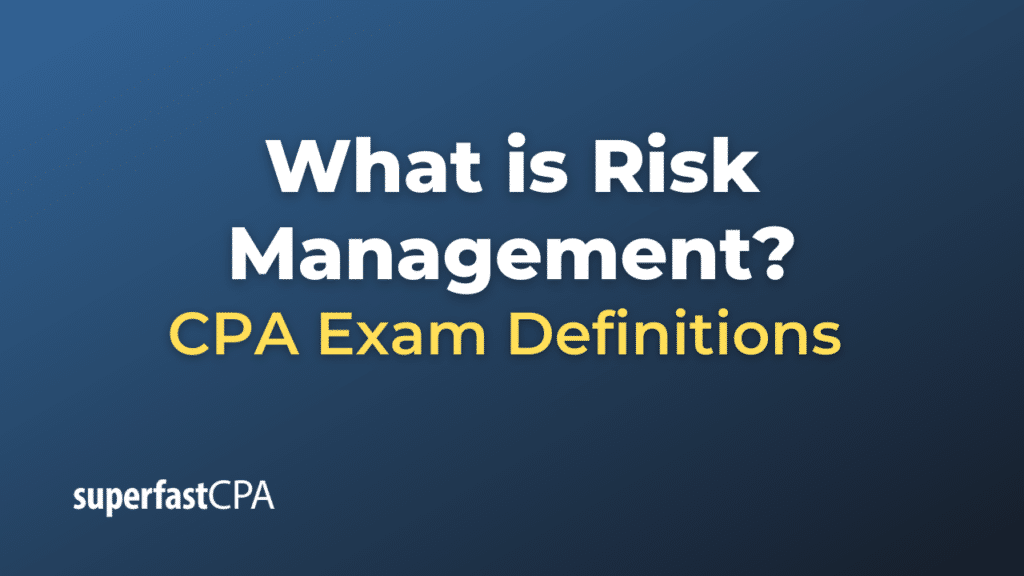Risk Management
Risk management is the systematic process of identifying, assessing, and addressing risks to ensure that the negative impacts of such risks on an organization or individual are minimized, while potential benefits are maximized. It’s an essential discipline across various sectors and functions, including finance, business operations, IT, and public health, among others.
Here’s a breakdown of the typical steps involved in risk management:
- Risk Identification: This is the first step where potential risks are spotted and described. For a business, this could involve everything from financial risks like currency fluctuations to operational risks like supply chain interruptions.
- Risk Assessment: Once identified, each risk is then evaluated to determine its likelihood and potential impact. This can be done qualitatively or quantitatively. Qualitative assessments might categorize risks as “low”, “medium”, or “high”, while quantitative assessments might assign specific percentages or financial values.
- Risk Prioritization: After assessment, risks are ranked according to their potential impact and likelihood. This helps organizations focus on the most significant risks.
- Risk Response : For each significant risk, a strategy needs to be developed to address it. Common strategies include:
- Implementation: The chosen risk response strategies are put into action. This might involve changes to business processes, purchasing insurance, implementing new technologies, or other measures.
- Monitoring and Review : After implementation, it’s vital to continuously monitor and review the situation to ensure that the risk management strategies are effective and to identify any new risks. Feedback loops are essential for refining the risk management process.
- Communication and Consultation: Throughout the risk management process, relevant stakeholders should be informed and consulted. This ensures transparency, builds trust, and leverages the collective knowledge of the group.
A well-executed risk management process can bring numerous benefits:
- Informed Decision Making: By understanding the potential risks and rewards of an action, better decisions can be made.
- Resource Allocation: Resources can be effectively channeled to areas where they are most needed to address significant risks.
- Enhanced Stakeholder Trust: Transparent and proactive risk management can build confidence among stakeholders, including investors, customers, and employees.
- Achievement of Objectives: By actively managing threats and harnessing opportunities, an organization is more likely to achieve its strategic, operational, and financial goals.
Risk management is not about eliminating all risks. Instead, it’s about understanding and managing risks so that an organization or individual can take informed risks in pursuit of their goals.
Example of Risk Management
Let’s consider a simplified risk management example related to a company planning to expand its operations into a new international market.
Company Scenario: TechFusion, a technology company that produces smart home devices, wants to expand its market presence by launching its products in Country Z.
1. Risk Identification:
- Currency fluctuations between the home country and Country Z could impact revenues and profitability.
- Cultural differences might influence the acceptance of TechFusion’s products.
- Local regulations might be stringent or different, affecting operations.
- Possible supply chain disruptions due to long-distance shipping and customs.
2. Risk Assessment:
- Currency fluctuations have historically varied ±5% annually.
- Market research indicates a 30% chance that cultural preferences might not align with TechFusion’s products.
- A preliminary legal review identifies potential compliance requirements, but specifics are yet to be detailed.
- There’s a past record of 15% of shipments to neighboring countries getting delayed.
3. Risk Prioritization:
- Currency risk and supply chain disruptions are deemed high due to their potential financial impact.
- Regulatory risks are medium but could move to high once more details are known.
- Cultural acceptance risk is medium.
4. Risk Response:
- Currency Fluctuations : Engage in hedging strategies to mitigate potential losses from currency fluctuations.
- Cultural Differences: Collaborate with local marketing teams to tailor advertising campaigns to align with local preferences.
- Regulations: Hire a local legal team to navigate the regulatory environment and ensure compliance.
- Supply Chain: Establish partnerships with reliable local logistics providers and maintain a backup inventory in strategic locations.
5. Implementation:
- The finance team sets up forward contracts to hedge against major currency fluctuations.
- The marketing team collaborates with local agencies to gain insights and customize campaigns.
- The operations team works on logistics partnerships and sets up a small backup warehouse in Country Z.
6. Monitoring and Review:
- Monthly reviews are set up to track currency movements and the effectiveness of hedging strategies.
- Sales data is analyzed quarterly to gauge product acceptance and adjust marketing strategies accordingly.
- Regular audits are scheduled to ensure regulatory compliance.
- Supply chain efficiency is reviewed quarterly.
7. Communication and Consultation : Throughout the process, TechFusion keeps its stakeholders, including employees, investors, and partners, informed about its risk management strategies and the progress of its expansion into Country Z.
By proactively identifying, assessing, and managing risks, TechFusion is better equipped to face the challenges of international expansion and capitalize on the opportunities this new market offers.













